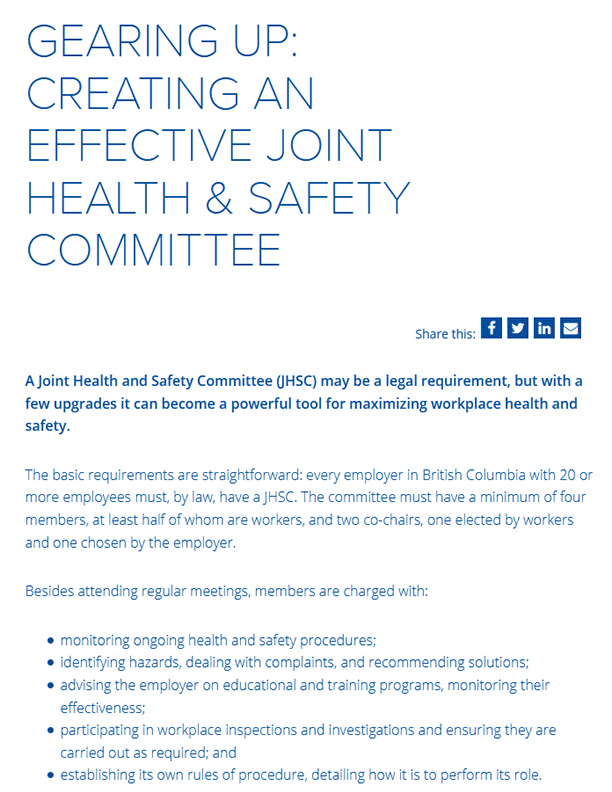July 31, 2017
Gearing Up: Creating an Effective Joint Health & Safety Committee
A Joint Health and Safety Committee (JHSC) may be a legal requirement, but with a few upgrades it can become a powerful tool for maximizing workplace health and safety.
The basic requirements are straightforward: every employer in British Columbia with 20 or more employees must, by law, have a JHSC. The committee must have a minimum of four members, at least half of whom are workers, and two co-chairs, one elected by workers and one chosen by the employer.
Besides attending regular meetings, members are charged with:
- monitoring ongoing health and safety procedures;
- identifying hazards, dealing with complaints, and recommending solutions;
- advising the employer on educational and training programs, monitoring their effectiveness;
- participating in workplace inspections and investigations and ensuring they are carried out as required; and
- establishing its own rules of procedure, detailing how it is to perform its role.
A functioning JHSC will do all of these things; many committees, however, take things a step further to become truly effective teams.
Recent regulatory changes are designed to help ensure that all JHSCs become effective, rather than just functioning teams. Besides new training standards for committee members, requiring anyone elected on or after April 3, 2017 to complete 8 hours of mandatory training on specific topics, there is also a requirement for an annual written evaluation of each JHSC.
To prepare for this, WorkSafeBC has created a Joint Health and Safety Committee Evaluation Tool, to help JHSC members and employers measure the effectiveness of their JHSCs. This online tool includes a series of questions designed to clarify the difference between the minimum legal requirements in each step and the gold standard of JHSC work.
For example, each JHSC is required by law to develop terms of reference, detailing the committee’s rules and responsibilities. An effective JHSC will do that but, in addition, will develop those rules with the participation of all committee members, review the rules periodically, and ensure that all members really understand the role of the committee and the extent of its authority.
A functioning JHSC will meet once a month. An effective committee will use an agenda, ensure each member attends or sends an alternate, and encourage equal participation by both employee and employer representatives.
Communication among committee members, co-chairs, the employer and all employees is also key. A JHSC is required to take minutes of each meeting and provide a copy to the employer. The employer, in turn, must post the names and work locations of committee members in the workplace as well as the minutes of the three most recent meetings. Ideally a JHSC will go further to ensure that everyone at the workplace is aware of the committee’s work and is encouraged to contribute ideas.
The law requires regular inspections of all workplaces. To really make these inspections count, the evaluation tool recommends, among other things, that both worker and employer representatives participate, that all committee members are trained in carrying out inspections, and that the inspections cover all work areas and shifts.
Use of this particular tool isn’t mandated, and workplaces are free to apply their own systems, but it’s a great place to start in ensuring that each JHSC is the best it can be.
go2HR is BC’s tourism & hospitality, human resources and health & safety association driving strong workforces and safe workplaces that deliver world class tourism and hospitality experiences in BC. Follow us on LinkedIn or reach out to our team.



